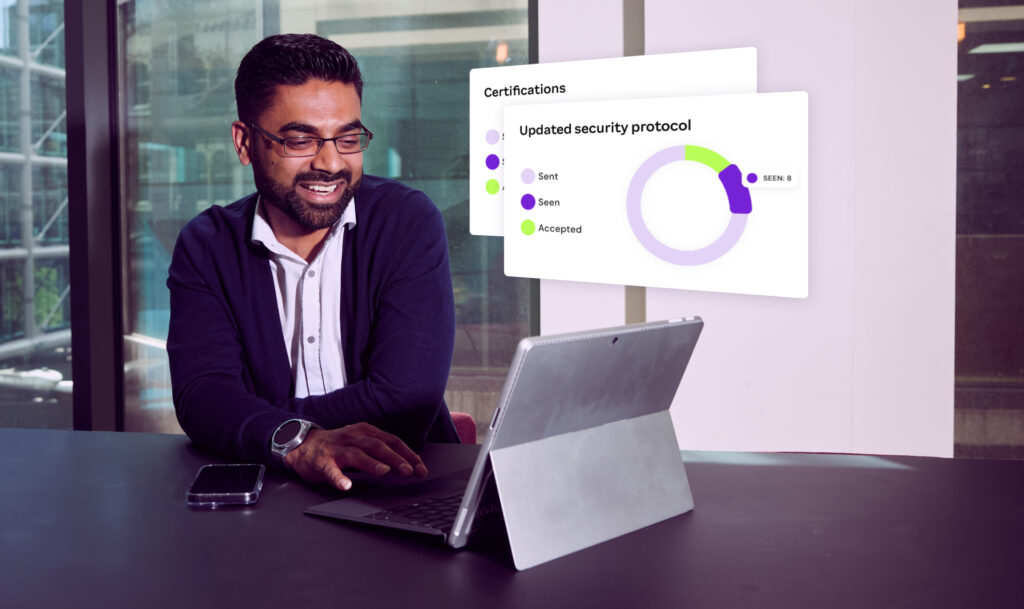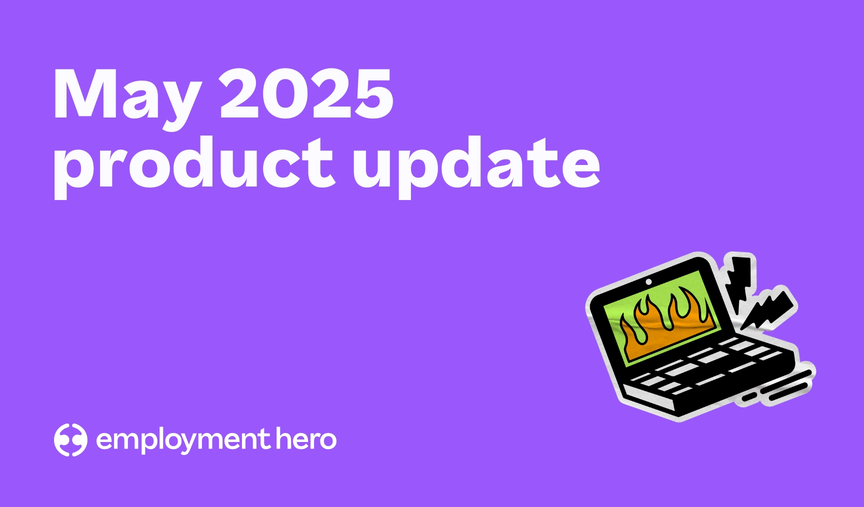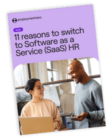Why should businesses use people analytics?
Whether you’re a business leader or HR manager, it’s important to understand the possibilities and potential of people analytics.

In today’s data-driven world, businesses have access to more information about their employees than ever before. From hiring and retention, to performance and engagement, every stage of the employee lifecycle can give business owners and HR professionals insight.
Collecting data is one thing, but if you don’t know how to use it, it’s not going to be very helpful. And how businesses use the data they gather is what sets successful businesses apart from the rest.
This is where people analytics comes into play. Not sure what it is? Keep reading and we’ll give you the lowdown.
What is people analytics?
People analytics (also known as talent analytics or HR analytics) is about being able to utilise and interpret human-oriented data to understand problems, aid decision making and anticipate future developments that improve employee performance.
The beauty is that big data is used throughout the entire employee lifecycle from acquisition to performance management and retention.
Three distinct factors have triggered business leaders’ unprecedented interest in human-centred analytics:
- The rapid uptake in big data and data analysis as a result of software and technological advancements.
- The pressure is being placed on HR departments to justify talent management decisions based on data-driven insights. Rather than using traditional means such as subjective judgement and intuition, business leaders are now opting for decisions to be made based on people analytics.
- The majority of HR departments are already sitting on a gold mine of employee data, such as demographics, performance outcomes, training, job history and salary. It’s only recently that businesses have seen the potential of leveraging this workforce analytics for goal-related purposes.
Most HR departments already collect HR data surrounding their team, so why is there a need for a specialised area of data analysts?
While data collection can help you get started, merely possessing this information isn’t enough. Without decoding and understanding employee data, the information will appear meaningless.
After all, it’s no use having all the ingredients to bake a cake without the recipe.
How does people analytics work?
In order to get a comprehensive understanding of people analytics, it’s important to get to grips with the process first. Employee data is made up of several vital components that flow into each other:
- Data is first collected to gather unique problem-solving insights.
- The data is then measured against previous data, like historical events or information.
- The results can then be analysed to identify any trends or patterns in behaviour.
- Lastly, insights can be applied to organisational strategies and decisions.
If you’re interested in implementing analytics into your HR operations, there are two key steps to help you get started.
Step 1: Identify the questions you want to be answered
Without relevant, strategic questions, it’s difficult to determine what exactly it is you’re looking for when collecting big data.
If you want to try and tackle business goals, it’s important to determine how your employees fit into these goals and the types of questions that need to be asked in order to achieve them.
For example, if your business needs to reduce costs associated with employee turnover, you want to start by identifying why your workforce is choosing to jump ship.
Are we offering little opportunity for growth and development? What kind of benefits do we provide to staff?
Step 2: Experiment with different statistical tools
There are a multitude of data measurement tools and software that help simplify data collection and present the information in easily identifiable graphs, charts, and visualisations.
The majority of people analytics tools use sophisticated data science and machine learning technology to produce more efficient, effective and accurate data that are reflective of their people.
If you want to get started, try experimenting with a few different tools to see what works best for your business. Having the right people analytics solution is crucial in providing valuable insights to your company.Note: Ensure all data collected is ethically sourced, legally compliant and integrated into a succinct reporting system. The system must be capable of aggregating and organising the data for future analysis.
Benefits of people analytics
People analytics has become a recent HR buzzword, with over 70% of businesses today investing in data scientists, people analytics teams and people analytics tools to better understand their people.
However, it’s a relatively new domain for many HR departments, with only 26% of organisations using people analytics tools effectively.
Human-centred analytics can help businesses make smarter, more strategic and informed talent decisions. Armed with data-driven knowledge, HR departments are equipped with actionable insights to source talent, increase performance and improve employee retention.
There are numerous benefits to incorporating people analytics into core HR systems, so let’s delve into more detail
1. Supercharge hiring
Thanks to data analytics, the time spent manually screening new potential candidates is dramatically reduced. Talent data analysis can create a shortlist of talent that’s suitable for the role and have the necessary qualifications, experience and other relevant attributes.
By leveraging insights derived from human-centred data, you can also ensure the right people are placed in the right jobs. The best part is it can help your business recruit a more diverse workforce by removing any implicit bias that could otherwise occur in manual screening.You can do this by tracking diversity ratios and ensuring equity is upheld throughout the hiring process.
2. Improves the employee experience
HR analytics can be used to determine effectively how your employees feel about their work and the organisation. When it comes to organisational culture, analytic approaches can be used to identify what motivates your employees and any areas in need of improvement.
3. Can help reduce employee turnover and absenteeism
When your employees decide to leave, there is often limited understanding as to why. This kind of inconclusive data provides no way of identifying trends or patterns in employee turnover and how they can be prevented.
Turnover is costly to any business, so it’s important to learn how to prevent this from becoming an ongoing issue. If your office has become a revolving door, people analytics can help you identify the root cause of employee turnover and absenteeism.
With these data points, Human Resources can use past data to identify patterns in employee behaviour and flag the kind which results in high turnover. They can also investigate the current level of productivity and engagement to determine areas in need of improvement.
By correlating both kinds of data, businesses are able to understand the causes of employee turnover and how it’s impacting their bottom line.
4. Evaluates the effectiveness of employee training
While it’s all well and good to offer training programs for staff, you need to have strong measurements in place to determine their level of effectiveness. People analytics capabilities can help score training and performance outcomes to reveal which courses produce the strongest results.
5. Can help you prepare for future talent needs
Predictive people analytics can help your business forecast talent needs that are critical to future operations. Succession planning will allow your business to prepare effectively for any new roles or positions long before they’re needed.
Workforce planning is key to understanding what your organisation needs in terms of experience, skills and qualifications to help you navigate any future uncertainty.
Challenges and considerations with people analytics
It’s clear that people analytics has plenty of benefits for businesses. But it’s not without its challenges. To get the most out of employee data while maintaining trust and compliance, business leaders and HR professionals must be aware of potential hurdles and know how to navigate them effectively.
How to ensure data privacy and compliance
Staying compliant is a huge factor across all areas of running a business, and people insights is no different. In fact with regulations such as UK GDPR in place, businesses have a legal obligation to protect employee privacy.
Some ways you, as a business owner or HR manager can do this is by:
- Being transparent about what data is being collected, and why.
- Obtaining consent before collecting personal data.
- Limiting access to sensitive information.
- Implementing strong data security measures.
Maintaining the trust of your team is essential, and any data collected should be used ethically and with clear business intent. Our best advice is to work closely with compliance and IT professionals to develop clear policies to make sure you’re meeting regulatory standards.
Overcoming resistance to data-driven HR practices
We all know that data can improve decision-making, but not everyone in your business will be on board straight away.
Some members of your team might be resistant to change, or worry that data analytics could lead to impersonal decision-making. So it’s important to remind your team that people analytics is another tool they have at their disposal.
To overcome this resistance we suggest:
- Communicate the purpose and value of people analytics clearly
- Highlight real-world use cases where data has led to better outcomes
- Provide training and support to help teams build data literacy
- Emphasise that analytics supports, not replaces, human decision-making
Creating a culture where data and experience go hand in hand can help drive adoption across your business.
Common pitfalls businesses should avoid when using people analytics
Introducing something new is always exciting, but without a considered approach, it’s easy to fall into traps. Mistakes can limit the impact of people analytics. But knowledge is power, so here are some of the most frequent pitfalls to look out for:
- Lack of clear objectives: Many businesses begin collecting employee data without a defined purpose. This can lead to an overwhelming volume of information with no real impact. It’s crucial to identify what business problems you’re trying to solve, so you know what insights to pay attention to.
- Poor data quality and integration issues: Inaccurate, inconsistent, or siloed data can undermine the value of your insights. For example, if employee records across HR and payroll systems don’t match, any analysis based on that data may be flawed. Ensure your data sources are integrated, up to date, and validated regularly.
- Over-reliance on quantitative data: Numbers alone don’t tell the whole story. Employee data should combine quantitative data (e.g. absence rates, turnover, performance scores) with qualitative insights (e.g. survey feedback, manager observations). Failing to consider context can lead to misinterpretation or one-size-fits-all solutions.
- Neglecting the human element: Employees are not just data points. And insights should be used to support people-centric strategies, not replace them. Over-automating decisions or ignoring employee perspectives can damage trust and morale. Use employee data to guide conversations, not dictate them.
- Not acting on insights: One of the biggest pitfalls is gathering valuable insights, then not acting on them. People analytics should lead to action. If insights aren’t shared with the right stakeholders or don’t inform tangible HR initiatives, the effort spent on analysis is wasted.
- Ignoring ethical considerations: Even when technically compliant, some data practices may feel intrusive to employees. For example, tracking email usage or keystrokes can create a culture of surveillance. Always consider the ethical implications of your analytics strategy and involve employees in conversations about data use.
Avoiding these common mistakes requires business leaders and HR professionals to take a strategic approach to employee data. When businesses take a considered and employee first approach to data, it can be a valuable tool in driving business objectives.
How to get started with people analytics
Introducing any new process or tool can feel overwhelming, but it doesn’t have to be complicated. And getting started with people analytics doesn’t mean you have to overhaul your entire HR system (Phew).
If you want to implement employee data and begin making more informed decisions, but aren’t sure how to do it, don’t worry, we’ve got you.
Choosing the right tools for people data
Using the right tools is a must. The tools you opt for will have a big impact on how effectively you can collect and analyse employee data.
When considering options, look for HR software or platforms that:
- Integrate with your existing systems (e.g. HR, payroll, and performance management)
- Offer user-friendly dashboards and reporting features
- Enable real-time access to key employee data
- Provide automation to reduce manual admin
- Prioritise data security and compliance
Still looking for a tool that can do all of this? Look no further than Employment Hero.

Employment Hero offers built-in people analytics features designed to help businesses turn employee data into actionable insights, without the need for spreadsheets or complex systems. The platform allows you to:
- Access real-time dashboards and reports across key HR metrics like turnover, engagement, absenteeism, and more
- Track performance trends and identify top talent through integrated performance management data
- Analyse employee data across departments, roles, or locations to make more informed workforce decisions
- Improve visibility for managers and leadership teams with clear, easy-to-understand employee data insights
- Maintain full compliance with robust data security and privacy features built into the platform
Building a data-driven HR culture
We obviously agree that having the right tools is essential, but creating a data-driven culture is more than that, it’s about mindset.
If you want to get the most from the data you collect, you need to promote a culture that values evidence-based decision-making across your business.
Here’s exactly how you can do it:
- Educate your team: Provide training to help HR professionals and managers understand how to interpret and use data.
- Communicate the benefits: Show how employee insights lead to better decisions and improved outcomes.
- Encourage collaboration: Break down silos between HR, finance, and leadership teams so that insights can be shared and acted on.
Lead by example: When leaders use and value people analytics, others are more likely to follow.
First steps for businesses new to people analytics
Here’s how to lay the groundwork and build a strong foundation for collecting, and using employee insights effectively:
Identify a priority area
Data is best when you know what you’re gathering it for. So start with a goal in mind and pinpoint a specific HR or business challenge you’re hoping to address. It could be anything from high employee turnover, to poor engagement scores, to long hiring times.
Identifying, and focusing on a problem helps you to stay on track and ensures data efforts are targeted. To identify priority areas, consider:
- What are our biggest people-related challenges right now?
- Where could better insights help us make smarter decisions?
Audit your existing data
Before diving in and collecting new data, first look at what you already have. This will prevent you from drowning in numbers.
We recommend that you look at where employee data is stored, such as in your HRIS, payroll software, or spreadsheets, and assess its quality. Is it up to date, consistent, and complete? Identifying gaps or inconsistencies early on can save time and prevent errors in analysis later.
Key actions include:
- Standardising job titles and departments
- Resolving duplicate or incomplete records
- Ensuring personal data is stored securely and compliantly
A common struggle lots of business owners and HR professionals find when analysing their data is that it’s spread across multiple different platforms, making it tricky to find and assess. If you’re looking to streamline the platforms you’re using, and make data analysis simpler, consider consolidating into one unified Employment Operating System.
Set clear goals
Without having clear goals, it’s easy to get lost and forget the purpose of the data you’re gathering. So make sure you define what you want to achieve through people analytics, as well as establishing key performance indicators (KPI’s) to track progress.
For example, if you’re trying to reduce turnover, a relevant KPI might be a 10% decrease in voluntary resignations over six months. Regardless of your goals, when setting them, make sure they are:
- Specific and measurable
- Aligned with business objectives
- Supported by actionable insights
Start small and scale
It’s easy to get overwhelmed, especially when implementing something new, so start small with a single process and build from there. This will give you the chance to test and refine your approach. Once you’ve proven success in one area, you can gradually expand your efforts to other parts of the business.
Examples of good starting points include:
- Analysing employee engagement scores within one team
- Tracking absenteeism trends in a specific region
- Reviewing onboarding effectiveness for new hires
Review and adapt
People analytics isn’t a one-off project, it’s an ongoing process. And as with anything, there’s always room for improvement. Regularly review your findings, gather feedback from stakeholders, and adjust your strategy as needed. You may discover new questions to explore or realise that some metrics aren’t as relevant as expected.
The most effective people analytics strategies are flexible and responsive to the needs of the business.Consider:
- Scheduling regular reporting intervals (monthly, quarterly)
- Sharing insights with key decision-makers
- Using results to inform policy updates, training, or leadership decisions
Supercharge your people reporting with Employment Hero
People analytics is more than just a fleeting trend or buzzword, it’s a powerful tool that can transform the way you manage, support and grow your workforce. By tapping into your people data, you can make smarter decisions, boost performance, and build a more engaged, productive team.
Employment Hero makes it easy to unlock the power of people analytics. With automated reporting, real-time insights, and a centralised HR platform, you’ll have everything you need to make informed, strategic choices for your business. Say goodbye to guesswork and hello to data-driven decision-making.
But Employment Hero is more than just a HR platform, our Employment Operating System takes the isolated elements of employment and integrates them into a seamless, human and AI-powered solution that empowers business leaders, HR professionals and employees alike.
Find and hire top talent with SmartMatch, seamlessly onboard new hires, automate complex payroll, drive employee engagement and more!
Related Resources
-
 Read more: Product Update: May 2025
Read more: Product Update: May 2025Product Update: May 2025
Follow our May 2025 product update as we share all of the latest and greatest features we’ve released over the…
-
 Read more: The Construction Industry Scheme (CIS): A Guide For Employers
Read more: The Construction Industry Scheme (CIS): A Guide For EmployersThe Construction Industry Scheme (CIS): A Guide For Employers
Discover our Construction Industry Scheme guide. Whether you’re a business owner or HR professional, understanding CIS is key for compliance…
-
 Read more: Dealing with mental health in business—From a HR professional
Read more: Dealing with mental health in business—From a HR professionalDealing with mental health in business—From a HR professional
Discover our in-depth guide to mental health sick leave. We look at what it is, why it is taken and…












